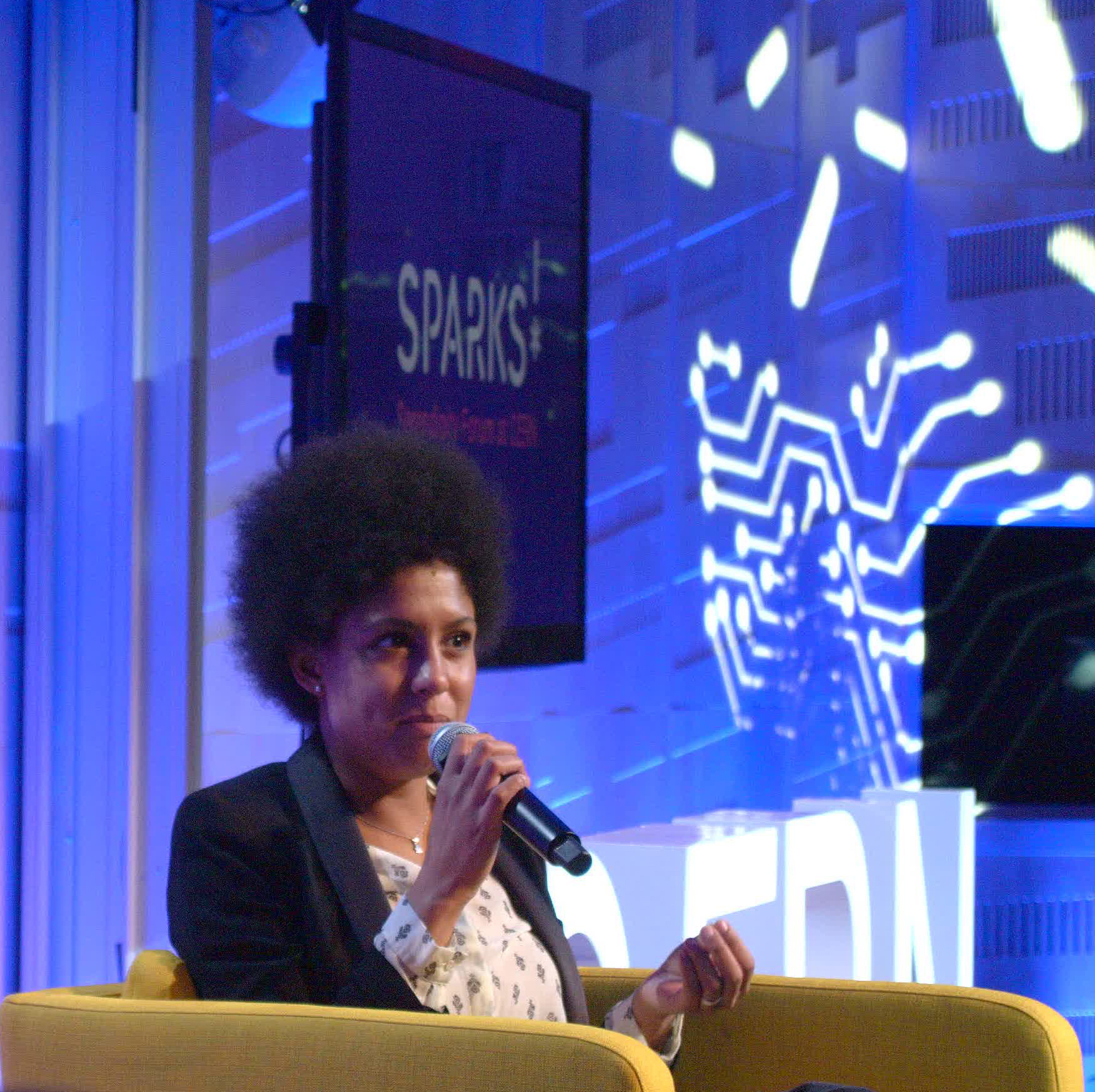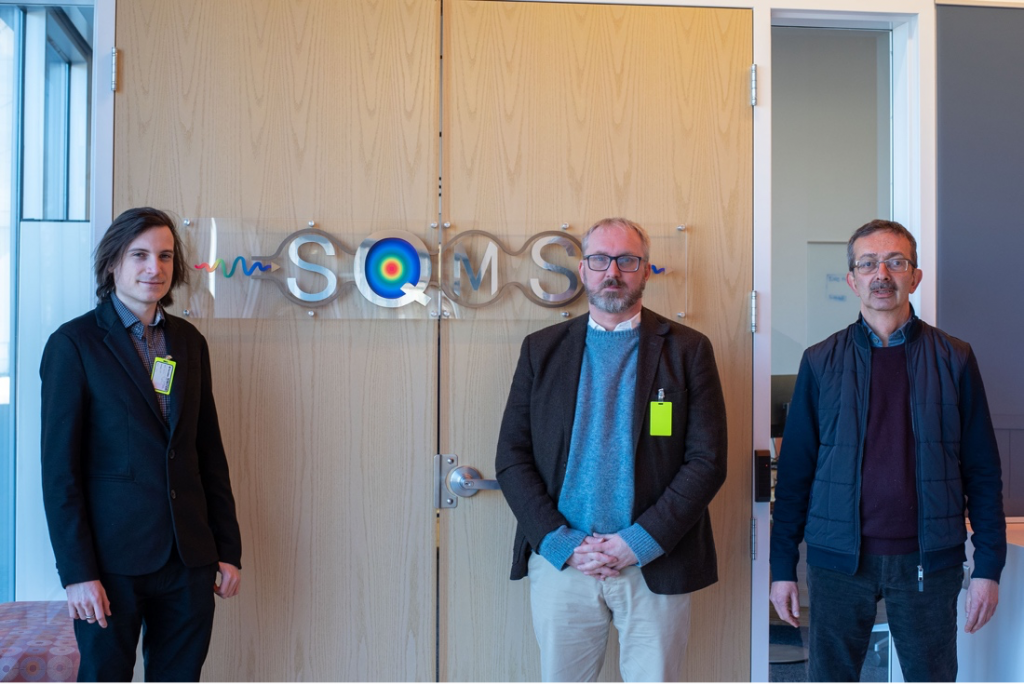
Associate scientist Jennifer Ngadiuba received two top awards last fall to advance artificial intelligence and machine-learning research in high-energy physics. Photo: Jennifer Ngadiuba
Jennifer Ngadiuba, an associate scientist at Fermilab on the Compact Muon Solenoid experiment, was always curious — she felt like the world was a puzzle to be solved. When she was young, she knew she wanted to study science to help solve this puzzle. Later, she realized her curiosity and research could help advance human knowledge and well-being in general.
The need to understand the truth behind mysteries of the physical world has guided her career. Her curiosity has led to Ngadiuba’s receiving two prestigious awards: The U.S. Department of Energy’s AI4HEP award and the Schmidt Futures AI2050 Early Career Fellows award. Both will enable her to expand development of new methods for more reliable and robust machine learning, using physics-informed models where humans are not needed in the decision-making loop.
Ngadiuba’s research focuses on designing efficient edge artificial intelligence for the real-time processing system of the CMS experiment. In the last year, her research has focused on understanding the feasibility of a novel data-acquisition approach for CMS, based on unsupervised learning. This approach, also called anomaly detection, has the potential to lead the field to uncover unknown and beyond the Standard Model physics.
She will now expand her research to improve the efficiency and robustness of edge AI models with physics information for different high-energy physics applications, including CMS, the Deep Underground Neutrino Experiment and accelerator technology.
Award for advancing artificial intelligence
The AI4HEP DOE Award supports the DOE Office of Science initiative in artificial intelligence research that focuses on using AI techniques to deliver scientific discoveries and to broaden participation in high-energy physics research. It represents new partnerships between researchers at DOE national labs and collaborating universities that will enable the next discoveries in high-energy physics.
Ngadiuba’s research was one of three national lab-led team projects to receive funding to continue artificial intelligence research for high-energy physics. Also, Fermilab is the only national lab with a scientist who will receive $2.96M over three years for her research.
This award will allow Ngadiuba and her team to expand capabilities by adding one AI associate, two postdoctoral research associates — one to work on a neutrino experiment and another on CMS — and at least one doctoral student from each collaborating institute.
Solving hard problems in AI
The Schmidt Futures is a philanthropic program that supports researchers from around the globe at various stages of their career who are solving hard problems in science and society.
In late 2022, Ngadiuba was one of 15 Schmidt Futures Early Career Fellows selected to solve hard problems in artificial intelligence through interdisciplinary research.
Nominees from 10 universities — and Ngadiuba, the only researcher from a national lab — each were selected to receive up to $300,000 over two years in AI research support. Ngadiuba holds an affiliate position at California Institute of Technology, which will set up and manage the grant to allow AI researchers to work with her group at Fermilab.
“I would like to help advance this field, and I am thankful to DOE and the Schmidt Futures Foundation for recognizing the importance of AI and ML in high-energy physics,” said Ngadiuba. “I am very thankful to the mentors who initially led me down the AI path and those who continue to mentor and inspire me in my current endeavors at Fermilab. I realize the potential of AI to help the field of high-energy physics, as well as the advantages and applications it brings to society.”
Fermi National Accelerator Laboratory is supported by the Office of Science of the U.S. Department of Energy. The Office of Science is the single largest supporter of basic research in the physical sciences in the United States and is working to address some of the most pressing challenges of our time. For more information, please visit science.energy.gov.
The United States and United Kingdom are sharing expertise and capabilities in the blossoming field of quantum information science across the pond. This new partnership between the countries will lead to new quantum devices, insights into their performance, ways to harness quantum information and discoveries in fundamental physics.
Research will be conducted under the Superconducting Quantum Materials and Systems Center, hosted by the U.S. Department of Energy’s Fermi National Accelerator Laboratory, with the United Kingdom’s National Physical Laboratory and Royal Holloway, University of London. With the additional institutions, the SQMS Center collaboration now totals 28 partners.

From left to right: Marius Hegedus, Tobias Lindstrom and Alexander Tzalenchuk stand outside the door to Quantum Computing Lab-3 during their visit to SQMS Center’s headquarters on Fermilab’s campus. Photo: SQMS Center
These new additions to the SQMS Center are rooted in goals to increase cooperation in the field of quantum information science between the U.S. and U.K. governments. These goals were set in a November 2021 joint statement that emphasizes the importance of growing an ecosystem of international partners with shared values. The statement also highlights the impact of quantum technology on global health security, climate change and efficient resource use.
“Our new U.K. partners bring unique characterization techniques that complement the SQMS Center’s strengths,” said Anna Grassellino, director of the SQMS Center. “This partnership advances the center’s mission of identifying and overcoming fundamental obstacles that interfere with quantum device performance, while also finding ways to use quantum devices to harness quantum information and perform physics and sensing experiments.”
New investigations
Quantum information science seeks to harness the behavior of quantum mechanics to process information in new ways, develop ultra-sensitive detectors and much more.
Under these new partnerships, researchers will investigate the following: losses of quantum information in quantum computing devices, new systems based on quantum technologies to search for new particles, new quantum algorithms, and the performance and fundamental limits of quantum computers.
“The areas the SQMS Center focuses on are building high-quality superconducting qubits and looking at ways in which this will scale for both quantum computing and fundamental physics,” said Sir Peter Knight, chair of the U.K. National Quantum Technologies Programme and SQMS Center advisory board member.
Scientists will use quantum computers to manipulate qubits — the basic building block of information used by quantum computers — to perform calculations that would be practically impossible for classical computers when the machines are fully realized.
“Superconducting qubits can be used as a quantum computing engine, but equally in the other direction for dark matter detection,” said Knight. “Quantum has become a major part of the scientific adventure that everybody wants to participate in, and SQMS is going to be a beacon of getting stuff done. NPL and RHUL researchers are excited to become collaborative SQMS Center partners.”
Cutting-edge capabilities
Quantum devices need to be cooled down to prevent information from being obscured or lost by noise produced by heat. Making devices ultra-cold might lead to better device performance and new insights on how quantum devices behave and operate.
RHUL performs cutting-edge research in quantum and hosts the London Low Temperature Laboratory. Researchers at RHUL have experience cooling quantum devices down to the microkelvin range, or millionths of degrees kelvin. This temperature regime is much colder than where researchers typically operate devices, which are the millikelvin range or thousandth degrees kelvin.
“What my group brings to the table is expertise in low-temperature physics into the microkelvin regime,” said John Saunders, a professor at RHUL and SQMS Center advisory board member. “For approximately the last 10 years, we’ve been working on developing new low-temperature platforms and working on cooling down quantum circuits and quantum materials to the lowest possible temperatures. We are very interested in cooling them down to ultra-low temperatures to see how they behave,” said Saunders.
This expertise in low temperatures complements the National Physical Laboratory’s capabilities. The National Physical Laboratory serves a similar function as the United States’ National Institute of Standards and Technology, both of which perform precision measurements to maintain measurement standards for their respective countries. NIST is also a core partner within the SQMS Center.
“Quantum has become a major part of the scientific adventure that everybody wants to participate in, and SQMS is going to be a beacon of getting stuff done.” – Sir Peter Knight, chair of the U.K. National Quantum Technologies Programme
“As the NPL head of science for quantum technologies, I lead a team of about 100 scientists working on various aspects of computing, sensing, communications, metrology, and materials,” said Alexander Tzalenchuk, the SQMS Center principal investigator for NPL. “In particular, we strive to understand and mitigate noise in superconducting circuits, which affects their ‘quantumness.’ We also work on algorithms and developing technologies that enable scalable quantum computing in the future. This formal collaboration is one of the first examples where the two countries can work together on closely aligned projects, which is enabled by the joint statement.”
“We want to make quantum technologies viable in order to provide new tools and capabilities that benefit our national initiative as well as, more broadly, the world,” said Abid Patwa, program manager for SQMS in DOE’s Office of High Energy Physics. “We need to learn more about the fundamental aspects of QIS, such as cryogenics, and to understand the underlying mechanisms that currently limit quantum computing devices.
“The United Kingdom continues to be an excellent partner to the United States and has the expertise as well as the essential resources to test and build on the QIS fundamentals,” said Patwa. “These efforts will further advance our insights in quantum research to enable this emerging technology.”
The Superconducting Quantum Materials and Systems Center at Fermilab is supported by the DOE Office of Science.
The Superconducting Quantum Materials and Systems Center is one of the five U.S. Department of Energy National Quantum Information Science Research Centers. Led by Fermi National Accelerator Laboratory, SQMS is a collaboration of 28 partner institutions—national labs, academia and industry—working together to bring transformational advances in the field of quantum information science. The center leverages Fermilab’s expertise in building complex particle accelerators to engineer multiqubit quantum processor platforms based on state-of-the-art qubits and superconducting technologies. Working hand in hand with embedded industry partners, SQMS will build a quantum computer and new quantum sensors at Fermilab, which will open unprecedented computational opportunities. For more information, please visit sqmscenter.fnal.gov.
Fermi National Accelerator Laboratory is supported by the Office of Science of the U.S. Department of Energy. The Office of Science is the single largest supporter of basic research in the physical sciences in the United States and is working to address some of the most pressing challenges of our time. For more information, please visit science.energy.gov.
This afternoon at 1:09 p.m., a contracted construction worker sustained injuries as a result of a fall at Fermilab’s PIP II construction area of the Batavia campus. The Fermilab fire department was dispatched immediately. A medical helicopter transported the individual to the nearest trauma center.
Fermilab officials are on site. Details of the accident are not available at this time.
